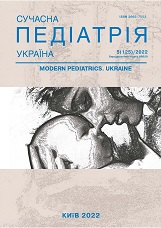Fatigue syndrome after a viral illness. Post COVID-19 exanthema infection. Ichthyosis of the skin of the feet. (Clinical case)
DOI:
https://doi.org/10.15574/SP.2022.125.135Keywords:
child, COVID-19, exanthema, diagnostic algorithm, indications for treatmentAbstract
The COVID-19 pandemic has posed many challenges to the medical community, a number of which will remain in the near future. Analysis of clinical cases helps to identify problems, to plan future research, which can change the understanding of the consequences of the disease.
As the first year of the pandemic progresses, there is a better understanding of the pathophysiology of the virus and the varied results of imaging COVID-19 in affected organs, which is crucial for improving the treatment of this complex disease and improving health outcomes.
It is described a clinical case of exanthema in an 11-year-old patient after COVID-19.
Clinical and immunological methods of investigation are used.
The child’s condition was of the moderate severity, caused by skin and asthenovegetative syndromes. The child was diagnosed with COVID-19; fatigue syndrome after a viral illness; post COVID-19 exanthema infection crustal ichthyosis of the legs.
A particular feature of this case is the occurrence of exanthema on the skin of the child after COVID-19. In these cases, the awareness of pediatricians should be raised to increase the level of knowledge of the correct diagnostic algorithm.
No conflict of interests was declared by the authors.
References
Anfilova MR. (2015). Dyferentsiina diahnostyka ta likuvannia virusnykh ekzantem. Klinichna imunolohiia. Alerholohiia. Infektolohiia. Spetsvypusk. No 1: 38-43.
Huxol H, Yaddanapudi K, Bushau-Sprinkle A, Palmer K, Bickel S, Morton R, Harris C. (2022). COVID-19 Disease in Children with Medical Complexity in a Pediatric Long-Term Care Facility: A Case Series. The Pediatric Infectious Disease Journal. 5: 23. https://doi.org/10.1097/INF.0000000000003587; PMid:35622420 PMCid:PMC9359677
Jimenez-Cauhe J, Ortega-Quijano D, de Perosanz-Lobo D, Burgos-Blasco P, Vañó-Galván S, Fernandez-Nieto D. (2020). Enanthem in Patients With COVID-19 and Skin Rash. JAMA Dermatol. 156 (10): 1134-1136. https://doi.org/10.1001/jamadermatol.2020.2550; PMid:32667631 PMCid:PMC7364334
Lipper GM. (2020, May). 'COVID Toes', 'Kawasaki' Rash: 5 Cutaneous Signs in COVID-19. URL: https://www.medscape.com/viewarticle/930180.
Lubell J. (2020, Jul). Is the Presence of Enanthem a Clue for COVID-19. Medscape. URL: https://www.medscape.com/viewarticle/934561.
Martinez-Lopez A et al. (2020). J Am Acad Dermatol. https://doi.org/10.1016/j.jaad.2020.08.006; PMid:32777318 PMCid:PMC7413159
Ortemenka YeP, Andriychuk TR, Solonar YaL, Sichkar ІB et al. (2019). Diagnostic information of clinical markers in the verification of acute infectious-inflammatory processes of the lower respiratory tract in children. Modern pediatrics. Ukraine. 4(100): 18-23. https://doi.org/10.15574/SP.2019.100.18
Zimmermann P, Curtis N. (2021). Why is COVID-19 less severe in children. A review of the proposed mechanisms underlying the age-related difference in severity of SARS-CoV-2 infections. Arch Dis Child. 106: 429-439. https://doi.org/10.1136/archdischild-2020-320338; PMid:33262177
Downloads
Published
Issue
Section
License
Copyright (c) 2022 Modern pediatrics. Ukraine

This work is licensed under a Creative Commons Attribution-NonCommercial 4.0 International License.
The policy of the Journal “MODERN PEDIATRICS. UKRAINE” is compatible with the vast majority of funders' of open access and self-archiving policies. The journal provides immediate open access route being convinced that everyone – not only scientists - can benefit from research results, and publishes articles exclusively under open access distribution, with a Creative Commons Attribution-Noncommercial 4.0 international license (СС BY-NC).
Authors transfer the copyright to the Journal “MODERN PEDIATRICS. UKRAINE” when the manuscript is accepted for publication. Authors declare that this manuscript has not been published nor is under simultaneous consideration for publication elsewhere. After publication, the articles become freely available on-line to the public.
Readers have the right to use, distribute, and reproduce articles in any medium, provided the articles and the journal are properly cited.
The use of published materials for commercial purposes is strongly prohibited.

